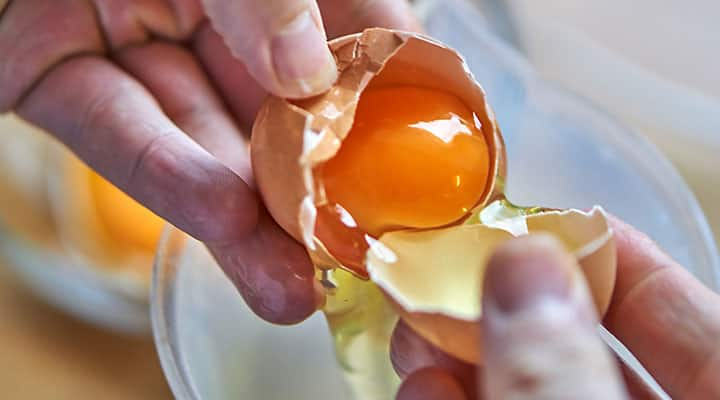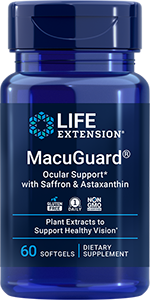
21 Astaxanthin Foods You Need to Add to Your Diet
Published: June 2024
So, you want to improve your diet and get as many nutrients as possible. You're eating more fruits and veggies, switching to more organic foods, and increasing your intake of protein and healthy fats. What else can you do to get the most out of your nutrition?
You might want to turn your focus towards the sea. We're talking about astaxanthin, an antioxidant that you probably haven't yet met but should be good friends with. Let's discuss what it is, how it can benefit you and where you can find it.
What is astaxanthin?
Astaxanthin is a carotenoid antioxidant. In other words, it's an antioxidant as a result of being a carotenoid (one of the most powerful antioxidants, as a matter of fact!). But what on earth does that mean?
Well, "antioxidant" is an umbrella term for any sort of compound that fights free radicals, which can impact the healthy function of your DNA, cell membranes, and other parts of the cell. And carotenoids are pigments—specifically, yellow, red, and orange—that are synthesized by plants.
Some well-known carotenoids include beta-carotene and lycopene, both of which can be found in high concentrations in tomatoes, among other fruits and vegetables. For example, sweet potatoes are a great source of carotenoids.
While you can find carotenoids in produce, astaxanthin is a little different. It's sourced almost exclusively from the ocean—more specifically from sources like algae, salmon, krill, shrimp, trout, lobster and crayfish. Astaxanthin-containing foods are often reddish in pigment.
Astaxanthin offers several health benefits—supporting heart health and immune function, and keeping your eyes healthy among them. But how can you add astaxanthin to your diet?
21 astaxanthin foods
As we mentioned, sources of astaxanthin are overwhelmingly found in seafood and are usually going to be red or pink in hue. In fact, there's no such thing as non-red/non-pink astaxanthin! So odds are, if you've ever had any red-hued seafood, you've probably consumed at least some astaxanthin. But good news for vegetarians: fish isn't the only source.
Not sure where to start? Here are 21 options for you to try that contain this healthy compound:
Red algae
—While you may be thinking of green algae on the ocean floor, we're talking about microalgae—Haematococcus pluvialis in particular. In fact, it's one of the most concentrated sources of astaxanthin!Canned salmon
—While the astaxanthin content will be higher in fresh salmon compared to canned salmon, it's an accessible option that provides an easy and more affordable way for many people to get the nutrients they are looking for.Salmon roe
—These are the unfertilized eggs of salmon, often enjoyed in sushi. The antioxidant ends up concentrated in eggs after moving up the food chain. It starts in microalgae and phytoplankton, which is then consumed by other sea creatures, eventually ending up in eggs laid by salmon.Trout
—Try baking this mild and flaky fish in the oven and serving it with your grain of choice and vegetables for a healthy and balanced meal.Arctic char
—The flesh and skin of this cold-water fish are both great sources, especially in more mature fish.Krill
—These small but mighty crustaceans are also a good source of astaxanthin (you'll mostly find them in supplement form). Bonus: krill is also low in fat and a rich source of omega-3 fatty acids!Crayfish
—Also called crawfish and crawdads, crayfish is a Southern cooking favorite that is often enjoyed boiled, but also found in staples like gumbo.Shrimp
—Shrimp are so easy to cook and can be an excellent source of astaxanthin. In fact, it's one of the most readily available foods on this list! They can be served as an appetizer, added to pasta or tacos, or even sauteed with garlic and butter. The options are virtually endless.Crab
—While it's not abundant in astaxanthin, this crustacean does contain the nutrient in small amounts. Keep frozen crab in the freezer until you're ready to cook it. If you purchase it live, cook it the same day!Sockeye salmon
—Known for their bright red bodies and green heads, this type of salmon is the third most common salmon species in the Pacific and is also a great source of fatty acids.Red rockfish
—This astaxanthin powerhouse can be grilled in just a few minutes, and it tastes heavenly with ingredients like lemon, butter and parsley on top.Eel
—You've likely had eel in your sushi, which is a huge plus because it's also a source of astaxanthin. Eel is very oily and, some say, a little on the sweeter side. (If you've ever had eel sauce, maybe you've noticed this.)Red snapper
—This fish has a flaky and firm texture and is similar to grouper. Red snapper is best prepared pan-fried, grilled or even baked, based on your preference.Rainbow trout
—A cold-water species found in the Pacific Ocean, rainbow trout is firm yet soft and flaky, and it almost has a nutty flavor.Lobster
—Lobsters, like many marine crustaceans, are also sources of multiple nutrients, astaxanthin among them. There are countless ways to prepare it, including lobster rolls, lobster bisque, and lobster risotto. Great, now we're hungry.Red mullet
—If you like the taste of oysters and scallops, you'll probably love this fish, which has a unique texture that may remind you of fatty white fish.Red perch
—Red perch, sometimes called Pacific Ocean perch or Pacific rockfish, is moist and a little sweet, with a flavor not unlike red snapper.Red sea bream
—A common staple in Japanese diets, this relatively large fish can be eaten head to toe—er, head to fin—so none of it goes to waste.Red porgy
—If you want to get more astaxanthin into your diet, red porgy, an Atlantic shallow-water fish, is the way to go. The meat is tender, flaky, and just a little bit sweet.Red drum
—You might know this better as redfish or channel bass. This white fish is lean and sweet, and like red perch, its flavor profile is similar to snapper.Egg yolks
—They might not be seafood, but yes, astaxanthin can be found in some egg yolks. Important caveat: it's only found in egg yolks if the chickens have been fed astaxanthin (check the carton!), but if you've been sticking to eating only the whites because you think they're healthier, you might want to reconsider your morning omelet.
Pro tip: Looking for even more carotenoids to add to your diet? Try zeaxanthin, a yellow pigmented compound commonly found in leafy greens like kale and spinach. Another good one to keep in mind is lutein, which is common in foods with green, orange, and yellow pigments. Get it from spinach, carrots, and egg yolks.
Explore Our Best Eye Health Supplements
Why do you need astaxanthin?
It's a smart idea to ensure you're getting this nutrient in your diet because it offers several benefits, largely thanks to the fact that it's a potent antioxidant.
Some of these benefits include:
Healthy eyes and brain
—Astaxanthin can support your overall eye health and is also good for your brain! It can benefit different facets of cognitive function, particularly when it comes to episodic memory, response time and working memory.Healthy inflammatory and immune responses
—Astaxanthin is also well known for helping promote a healthy inflammatory response. It achieves this by inhibiting inflammatory cytokines to support whole-body health. For this reason, and because of its antioxidant properties, it also supports a healthy immune response.Skin health
—Astaxanthin can help protect you against ultraviolet exposure so you can keep your skin youthful as you age, especially when it comes to maintaining smoothness and hydration.Exercise recovery
—Finally, astaxanthin can even help support exercise metabolism, performance, and recovery—again, thanks to its antioxidant properties. So, if you're training hard in the gym and feeling occasional muscle soreness afterward, this can be a great supplement to add to your everyday routine. Side note: astaxanthin is fat-soluble, so you should take it with food.
How do you get astaxanthin if you don’t eat seafood?
As much as you can, your top priority should always be to get the nutrients you need from nourishing your body with minimally processed foods. However, getting everything from diet alone is virtually impossible. That's where supplements come in.
Astaxanthin supplements might be especially helpful for people who don't like seafood or can't tolerate it. While it's true that you can get this antioxidant from certain egg yolks and a few other non-fish sources, it's going to be hard to get enough from diet alone. In this case, supplementing with astaxanthin is important if you want to enjoy the health benefits of this compound.
Which is better: astaxanthin or CoQ10?
If the benefits of this compound sound familiar and you've been supplementing with CoQ10, that's why! The two have a lot in common. However, they're special in their own ways and make a great duo, so you might even want to consider taking them together. Before you try any new dietary supplements, it's always a smart idea to speak with your healthcare provider.
Still not sure what you need? Take our quiz to help you fill in the gaps and support your healthiest self.
Resources
- Ambati RR, et al. "Astaxanthin: sources, extraction, stability, biological activities and its commercial applications—a review." Mar Drugs. January 2014. https://www.ncbi.nlm.nih.gov/pmc/articles/PMC3917265/
- Bauer A, et al. "Direct extraction of astaxanthin from the microalgae Haematococcus pluvialis using liquid–liquid chromatography." RSC Advances. July 2019. https://pubs.rsc.org/en/content/articlelanding/2019/ra/c9ra03263k
- Bjerkeng B, et al. "Astaxanthin and its metabolites idoxanthin and crustaxanthin in flesh, skin, and gonads of sexually immature and maturing Arctic charr (Salvelinus alpinus (L.))." Comp Biochem Physiol B Biochem Mol Biol. March 2000. https://pubmed.ncbi.nlm.nih.gov/10818273/
- Brown DR, et al. "Astaxanthin in Exercise Metabolism, Performance and Recovery: A Review." Front Nutr. January 2018. https://www.ncbi.nlm.nih.gov/pmc/articles/PMC5778137/
- Giannaccare G, et al. "Clinical Applications of Astaxanthin in the Treatment of Ocular Diseases: Emerging Insights." Mar Drugs. May 2020. https://www.ncbi.nlm.nih.gov/pmc/articles/PMC7281326/
- Kidd P. "Astaxanthin, cell membrane nutrient with diverse clinical benefits and anti-aging potential." Altern Med Rev. December 2011. https://pubmed.ncbi.nlm.nih.gov/22214255/
- Kohandel Z, et al. "Anti-inflammatory action of astaxanthin and its use in the treatment of various diseases." Biomedicine & Pharmacotherapy. January 2022. https://www.sciencedirect.com/science/article/pii/S075333222100963X
- Koomyart I, et al. "Astaxanthin stability and color change of krill during subcritical water treatment." J Food Sci Technol. September 2017. https://www.ncbi.nlm.nih.gov/pmc/articles/PMC5602969/
- Park JS, et al. "Astaxanthin decreased oxidative stress and inflammation and enhanced immune response in humans." Nutr Metab (Lond). https://www.ncbi.nlm.nih.gov/pmc/articles/PMC2845588/
- Sztretye M, et al. "Astaxanthin: A Potential Mitochondrial-Targeted Antioxidant Treatment in Diseases and with Aging." Oxid Med Cell Longev. November 2019. https://www.ncbi.nlm.nih.gov/pmc/articles/PMC6878783/
- Tominaga K, et al. "Protective effects of astaxanthin on skin deterioration." J Clin Biochem Nutr. July 2017. https://pubmed.ncbi.nlm.nih.gov/28751807/
- "Carotenoids." Data on file.
- "Sockeye Salmon." Wild Salmon Center. https://wildsalmoncenter.org/salmon-species/sockeye/
- "Understanding antioxidants." Harvard Health Publishing. January 2019. https://www.health.harvard.edu/staying-healthy/understanding-antioxidants
Like what you read?
Please subscribe to get email updates on this blog.












